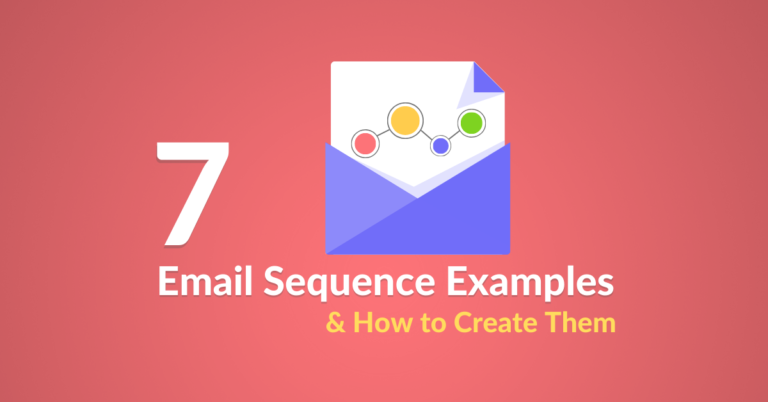Does it feel like you’ve done everything right, yet your prospects and customers don’t show any engagement signs toward your business?
The bad news: Several things could be preventing you from building a stronger customer relationship.
The good news: You can fix that and keep your prospects and customers around you by implementing the right email sequence types.
Below, we explore:
- What does an email sequence look like?
- What is an email sequence
- Why should you stay aware of the audience and purpose when creating email sequences?
- 7 Types of email sequence examples to copy
- How to create an email sequence
What Does an Email Sequence Look Like?
Email is one of the most popular communication methods used today.
But, so many people get bombarded with emails they perceive as irrelevant that it’s increasingly challenging for marketers to figure out how to resonate with their audiences.
However, succeeding in that aim is imperative, especially since email recipients have so many possible distractions.
Marketers must work exceptionally hard to have a top-of-mind presence with their audiences.
The email sequence examples here will help to do that. While researching email sequences, you’ll find that they also have other names, such as drip emails and autoresponders.
However, the critical thing to remember is that they serve the same function regardless of the name used.
As you continue to read through the information here, it’ll become evident why email sequences are so critical to use for connecting with your audience. Let’s dive in.
What is an Email Sequence?
Even marketers who have not actively reached out to customers with email sequences have undoubtedly received some of these correspondences before.
Using an email marketing sequence is the process of sending people emails at different stages as they move through the sales funnel.
Moreover, there are different sequences to use, depending on the purpose.
Perhaps you’re wondering how to create the best email marketing sequence.
That’s a natural question to have at this point, but keep in mind that there is no universally valid email that’s ideal for every case.
Instead, it’s essential to be aware of your audience’s needs and think about what you want the emails to achieve.
That’s why most drip campaign examples directly assist with achieving your business objectives. For instance, they might help you nurture leads, communicate with customers more regularly or re-engage with lost customers in a scalable way.
Great drip email campaigns are all about defining the message for the target audience. So, you’d have different emails written for blog subscribers versus people who’ve just ordered something from your company.
Make the first email in your drip sequence exceptionally catchy, but be sure it doesn’t seem like junk mail.
For example, since one in three workers failed to identify email phishing scams correctly, often specifically target organizations, any content from email sequences must seem as relevant to the sender and unlike a potential phishing email as possible.
Additionally, don’t forget that any email sequence requires time, patience, and attentiveness to your audience to create. Don’t rush through the process.
Instead, realize that you almost certainly won’t come up with the best emails to send in sequence immediately. You’ll gradually learn and improve with each attempt until they’re finally the best they can be.
How to Create Email Sequence Templates?
Earlier, we mentioned that the content in a sequence of emails differs depending on the goals you have for the audience or the business.
Similarly, the precise steps for creating an email sequence vary depending on the tool a person uses.
For example, Automizy is a brand of email sequence software that takes people through step-by-step processes for doing things like building automations, sending campaigns, and running reports.
But, in general, creating an autoresponder series that gets results means understanding the various needs a person has as they move through each part of the sales funnel.
Additionally, it involves writing content that shows your company is in an excellent position to address them. The content must make sense to the recipient to make them engage with it.
People understandably want to know how many emails they should create within a sequence. It’s a good idea to plan for four to six spread out over one to two months.
This means you’ll likely send different email sequences to people depending on their history with your company and the type of relationship you have with them.
Are they frequent buyers, or are they people who typically only make purposeful, large purchases a couple of times a year?
Specific email components, such as the subject line, body content, etc., can make people more or less likely to engage with a drip email.
For example, the email’s body must get to the point quickly. People may not have the patience to scroll excessively to get all the details, especially if they are viewing the content on small smartphone screens.
Plus, the subject line has to entice them enough to make them want to click into the email and learn more.
Why Should You Stay Aware of the Audience and Purpose When Creating Email Sequences?
It can be tempting only to build one or two email sequences and distribute them to all the people on your email list. Indeed, it could seem like that’s a time-saving technique, but it’s one that will almost certainly fall short for your email campaigns.
We’ve already talked about relevance, and it’s highly unlikely you’ll be able to create a couple of sequences that apply to every audience member.
The techniques you use varies depending on if you’re targeting B2C or B2B recipients, for example. B2B emails may get read by several decision-makers at a company before an action occurs or a relationship begins.
But, B2C consumers often buy things after seeing one or two promotional materials, such as a TV ad or a banner at the top of a website.
Sometimes, you’ll also use a drip campaign for a relatively short-term but highly purposeful reason, such as a product launch email sequence.
Then, your first email in the sequence — sent ten days before the product’s debut — is a teaser.
The next one, given to readers five days before the launch, has more concrete details about the product and may include things like specifications and images.
Another time-based reason to make an automated sequence of emails is to invite people to a webinar.
In that case, you must answer the Who, What, When, How, and Why details about the event for attendees.
And, don’t overlook the extras, such as whether attendees should have specific skills before attending or if the webinar has a Q&A session planned.
Remember, one of the primary goals of useful email sequences is to support a person’s journey through the sales funnel.
That often happens if you send emails triggered by a person’s action. Marketers can enjoy specific benefits by customizing the emails in a sequence.
As such, they should think carefully about which actions they want recipients to take when they craft the content, as well as which audiences will read the emails.
7 Types of Email Sequence Examples to Copy
Now that we’ve gone through some broad characteristics of the types of email sequences you might make at your organization, it’s time to take an in-depth look at specific email automation examples that serve dedicated purposes.
As we go through them, you’ll likely start identifying many of the automated email funnel techniques mentioned earlier.
Pay particular attention to the provided screenshots of the sequences, as well as the accompanying descriptive text.
Both of those components should make it easier to build email sequences that work for your audiences.
1. Lead Nurturing Email Sequence
A nurture email series is ideal for sending out at the beginning when a person engages with your lead magnet.
That content could be a white paper, a downloadable checklist, or an ebook, to name but a few.
The first email a person gets after requesting your lead magnet should deliver the item as promised.
It’s ideal if you can keep your messaging as on-brand as possible, as Dims does in these furniture email examples.

Try an autoresponder sequence that features an appealing but straightforward Welcome graphic, plus mentions the person’s first name.
Then, in your first sentence, you might give a reminder that the company gave the recipient freebies in exchange for signing up to an email.
If you take that approach, give the person a rundown of the benefits they get for being email subscribers.
Then, you reduce the chances that they’ll enjoy the free stuff without taking further desirable actions.
Besides welcome emails, other content in the lead nurturing sequence may include educational content or material that highlights your expertise.
Be careful not to assume that new leads are ready to buy. If your content for lead nurturing focuses too much on making sales and urging people to buy as soon as possible, many of them may feel overwhelmed and get turned off by your tactics.
Lead nurturing examples capitalizing on education should include a topic that many email list subscribers likely want to know about before purchasing something from the company.
Using clear steps and the helpful images make the content easy to remember and refer to as a person proceeds through stages.
Assure the reader that your business is available to assist at any point.
When distributing lead nurturing emails, the key is to make sure that people get messages frequently enough to keep your company in their minds, but they don’t receive messages viewed as spam.
Automizy has a tagging feature that automatically adds and removes tags when people are at specific parts of a campaign.
2. Conversion Email Sequence Templates
The purpose of a conversion email sequence is to turn someone on your email list into a well-qualified, highly converting lead.
Many companies do that by offering something that eases the friction that could stop a person from staying interested.
Examine this conversion email from a company that offers the Candy Crush Jelly Saga game. It gives people a type of game currency they can use to start playing without making an up-front investment.

We can assume the hope is that people will get hooked enough on the game by using the free gold bars that they’ll use them up and eventually need more.
The next email in the sequence should come at a time when the average game player would have recently used up their complimentary gold bars.
It should prompt a person to respond by purchasing more gameplay goods and remind them of what they miss through inaction.
Always be sure your conversion email is appropriately specific and connects to what you want the recipient to do.
The language you use varies depending on if you’re trying to get a person to buy something from a sale, sign up for a subscription or take part in another activity that helps your company.
3. Engagement Emails

You can probably guess from the name that a sequence of engagement emails should urge the recipient to get engrossed in the emails instead of ignoring them.
The content of such an email sequence template varies depending on your goal.
But, the subject line should contain information that’s intriguing or makes people feel like they’re missing out if they don’t read the message.
Audible, the audiobook brand, excels at engaging its members. A recent example of an email promoting a sale had a subject line reading: Escape into a great listen: Save on 300+ titles.
The content of the email contained a single linked image that gives readers the details of how to take advantage of the sale and how long the discounts last.
Then, if people don’t respond to the original email, Audible adjusts the subject line to read “Ends Soon:” followed by the subject line from the initial email.
So, if you use this kind of email autoresponder series, it’s essential to have something in your automation tool that recognizes if a recipient acts on the offer.
When recipients keep getting emails for offers after making purchases, they’ll get annoyed and may unsubscribe.
If you send engagement emails to align with time-sensitive campaigns, trigger your emails to send on a schedule that makes sense for the length of the promotion.
The longer it lasts, the more you can space the emails out.
Some engagement emails have elements where people can get additional perks by encouraging their friends to participate.
Then, one of the emails in your engagement sequence could thank the initial recipient for showing interest and inform them of what rewards they could earn by having friends get in on the fun.
4. Onboarding Email Sequence Examples
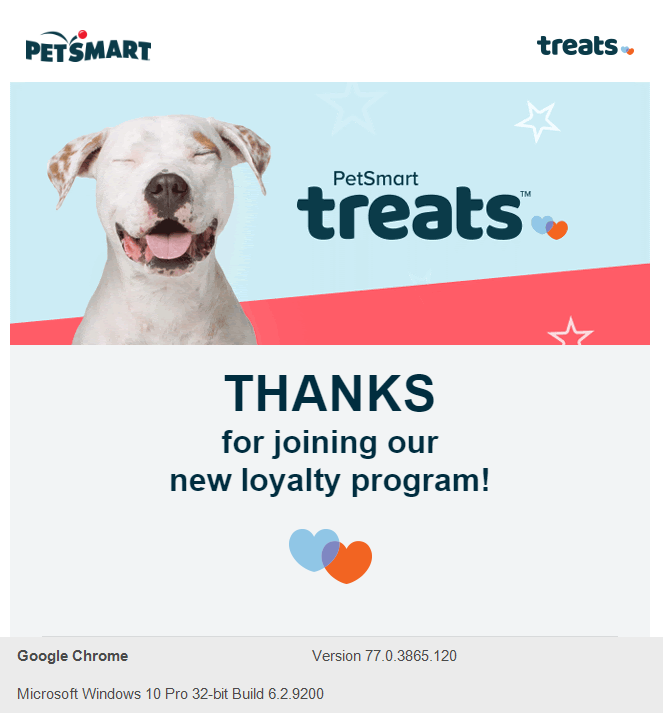
An onboarding email gives the recipient everything they need to stay engaged and use your product.
For example, onboarding emails equip people to book appointments, start using products, or find out about the services they’re testing during trials.
The email above from AWS walks people through a three-step process for making the most of the service.
However, one thing it doesn’t do is mentioning the recipient by name. Taking that small step to personalize the content enables a company to convey that they don’t merely think of a person as a number.
Once a person has a few days to work with the material in the first onboarding message, it’s smart to send another to address any possible frustrations.
If a customer feels unsure of where to get help or feels that assistance is not available to them, they likely won’t remain customers for the long-term.
The next email in the sequence could provide some further tips for using a product or service, plus give an email or phone number that people can use to connect with the company and ask for assistance if required.
Alternatively, link to a support database or other online resource readers could use to troubleshoot issues without immediate help from the company.
5. Re-Engagement and Abandoned Shopping Cart Email Sequences
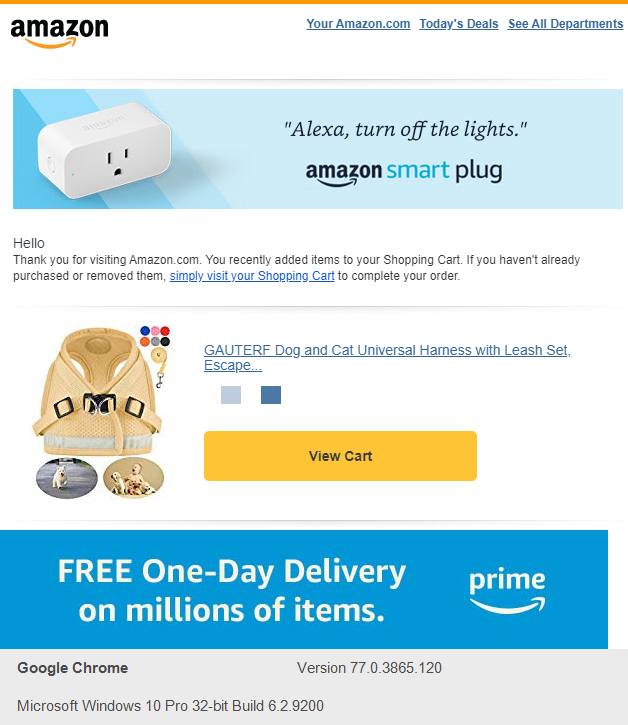
Companies work hard to earn leads, and the most successful ones know that they have to work hard to keep them.
That’s where re-engagement and abandoned shopping cart emails can be especially helpful. Shopping cart abandonment is only one scenario where you might need to use a re-engagement sequence.
Numerous other possibilities exist, such as if people didn’t understand your product or service or only intended to use your company to fulfill a one-time need.
This abandoned cart email from Birchbox, the personal care subscription box service, mentions the product the person didn’t buy and includes links to guide the person through completing the purchase.
See how the email features FAQ, Contact Us, and Support links?
Those minimize the possibility of the recipient thinking it’s too hard to get the information they need to feel confident about finishing the purchase.
The best email marketing sequence can anticipate a person’s needs before they address them, and this example does that well.
You can also send re-engagement emails if it’s been a while since a person interacted with your company, and they used to do it frequently.
The subject lines might say something like, “We miss you!” or “Come back and see what’s new!”
Also, consider making re-engagement sequences that make people feel excited about continuing a relationship with your brand.
Body & Soul is an annual Irish independent music festival that celebrated its 10th anniversary in 2019.
One of the things that helped the festival exist for so long is that it keeps mailing list subscribers updated about what to look forward to next.
The content informs people that the company behind the event does more than just one festival per year.
The embedded links help set expectations, as well. Step into the shoes of your readers and ponder what might make them lose interest in your company.
Then, combat those possibilities with tailored content.
6. Follow-Up Sequences
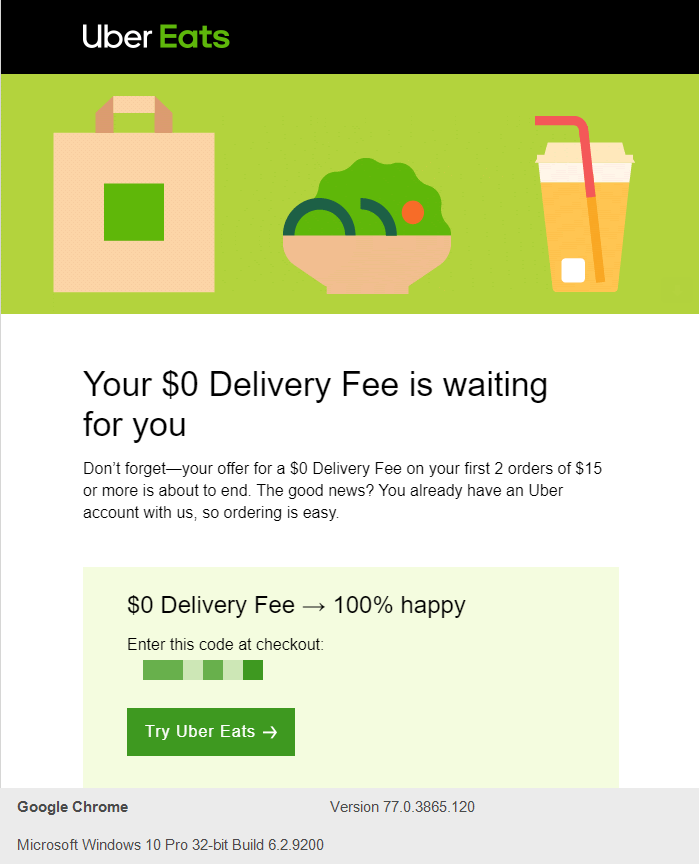
The first email sequence covered here was for lead nurturing.
Our intention here was to make people feel glad for signing up for a newsletter or doing something else that caused them to request your lead magnet.
But, people don’t always download the lead magnet content as soon as they get it. In that case, it’s time to prompt them with a follow-up sequence.
This autoresponder email series can be more straightforward than you may think. The first message is your welcome content.
But, if people don’t retrieve the collateral that you put inside the welcoming material, the next email in the sequence reminds them to do it.
Follow-up sequences work exceptionally well if the downloadable content comes via a dedicated link that expires after a week or two.
Shutterfly sends a version of a follow-up sequence if customers start creating products at their site and don’t finish them.
The email shown below features a discount code that people can use if they decide to complete and purchase their projects within days.
Follow this approach and make people aware of the urgency and what they’ll lose by not following through with an action.
7. Renewal Sequences
Renewal sequences interact with users before the time runs out on their current subscription plans.
As such, these email sequence templates usually tell recipients how long they have before a subscription runs out, as well as what happens if it lapses.
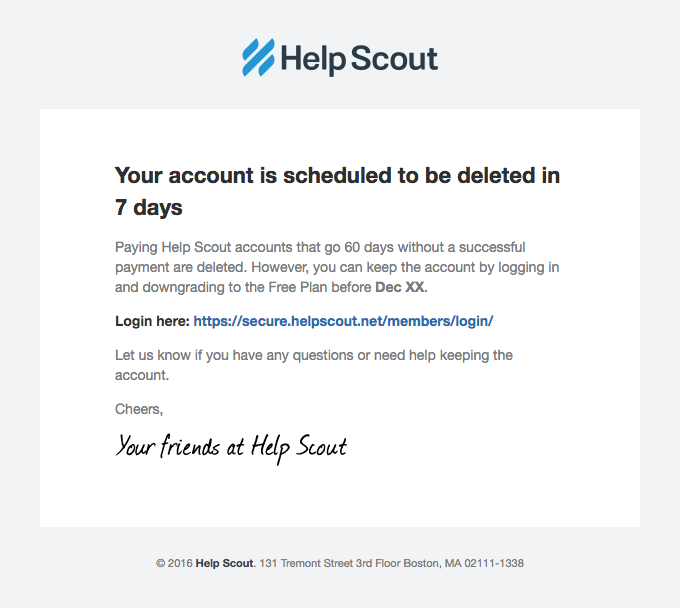
Take note of how the email above gives a person the option to downgrade to a free plan.
This content emphasizes that the company wants to keep the individual as a customer, even if they are not a paying one.
After all, the assumption is that the reader may stay happy enough with the service that they upgrade to a paid plan later.
These email sequences can also have content that mentions how you’re sorry to see a customer go.
Then, you might bring up how you want to make it right and invite the person to get in touch.
That’s an example of how a person might ultimately decide to let a subscription or plan run out, but sequenced emails delivered at the right times could keep the relationship going.
Never use a threatening tone in a renewal sequence. Doing that could make a customer lose trust.
How to Create an Email Sequence
To create a successful email sequence follow these four steps below:
Step 1: Choose when to trigger your emails
In Automizy, you can create personalized and automated email workflows that can get triggered when a contact:
- Gets added to an email list,
- Submits a registration form on your website,
- Visits a page,
- Clicks a link in an email, or
- Gets a tag.
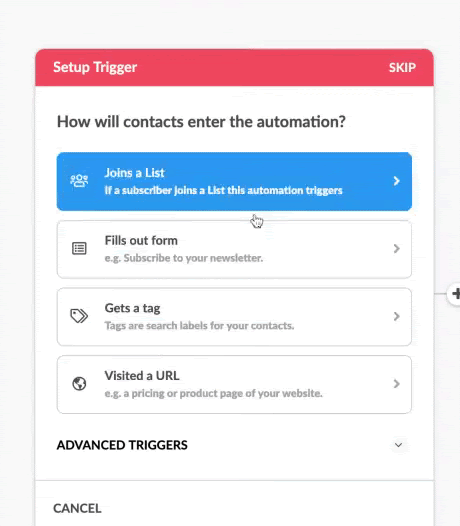
First things first, you need your choose your triggers and select when you want to include in your email sequence.
Triggers allow you to start email automation and apply actions to your subscribers.
Use triggers to follow-up to previous engagements from contacts and achieve your email sequence goals.
Step 2: Create a drip email sequence
Your email sequence is made of more than one email to communicate effectively with your prospects.
A drip email campaign is a triggered sequence of automated emails sent on a predefined schedule. Targeting email subscribers to achieve a specific result.
Here is an email sequence example created in Automizy.
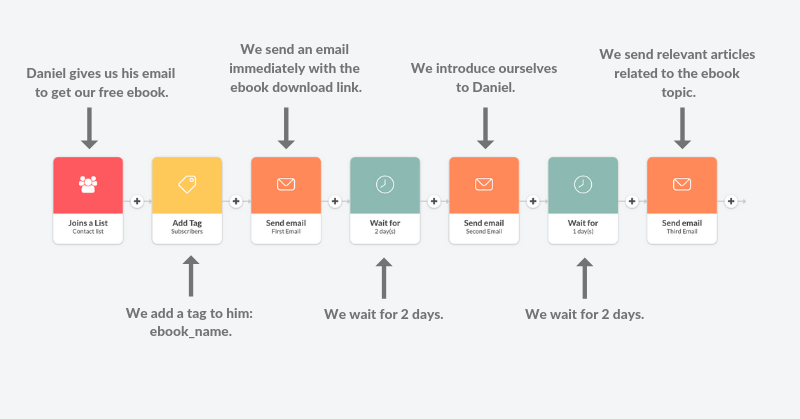
Besides scheduling emails in your sequence, use contact tagging to send more personalized content.
With the contact tag :ebook_name: we can define what kind of content attracted the subscriber in the first place and set up targeted email campaigns.
Using this information we could send another article related to the ebook topic to nurture the lead.
You could create a more sophisticated email sequence with behavioral email workflows.
Step 3: Behavioral email workflows
Personalize your messages to your email subscribers based on their engagement with your email funnel.
Here is how you can do it.
Use “If/else” conditions to personalize messages, e.g. send emails to contacts based on their interaction with your business.
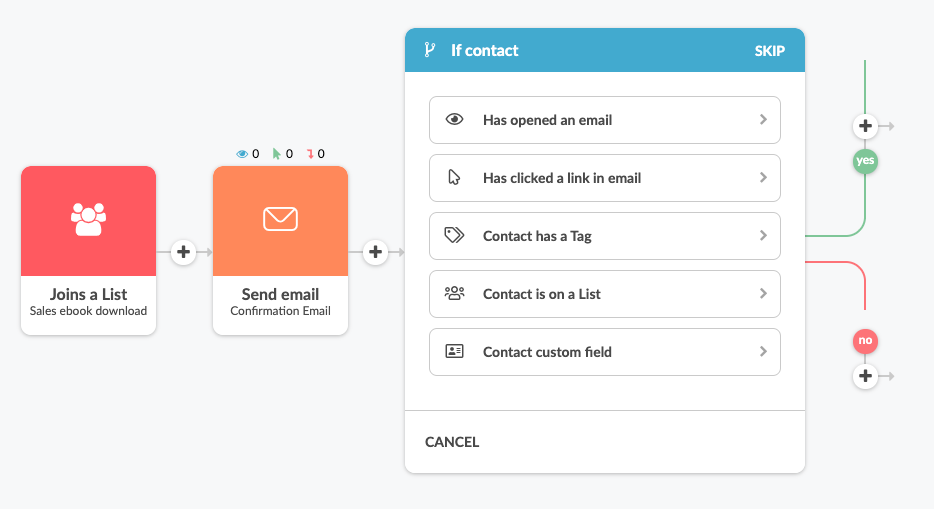
With the intuitive visual automation builder of Automizy, you can create behavior-based email sales funnel in minutes.

Create and Deliver Email Sequences With Confidence
I hope that this information gives you the know-how needed to build autoresponder sequences that cause the responses you want from your customer base.
It takes time to create a great email sequence — and marketers should not try to do it in haste.
But, the payoff can be significant because this technique allows people to receive messages that are maximally appropriate for them based on where they are in the buying journey or what actions marketers want them to take.
Even better, the automation component allows marketing professionals to get more done with less effort.
These email sequence examples will get you off to a good start and bring inspiration for applying automation to your campaigns.
Marketers should not anticipate that an email sequence will be perfect on the first attempt, but they have the best chance of getting ideal outcomes when using specialized tools and taking the time to understand audience needs and respond accordingly.
Conclusion
There you have it all!
Use the above 7 email sequence types to build stronger customer engagement, convert prospects to customers and grow your revenue.
The sooner you start using similar email sequences, the sooner you’ll take advantage of your email marketing.

